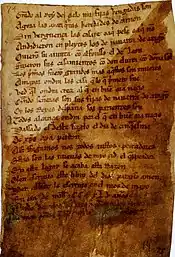Andean Spanish
Andean Spanish is a dialect of Spanish spoken in the central Andes, from western Venezuela, southern Colombia, with influence as far south as northern Chile and Northwestern Argentina, passing through Ecuador, Peru, and Bolivia. It is influenced principally by Castilian, Canarian and Andalusian Spanish, which is favoured in the cities, but in rural areas and some cities, there is influence of Quechua, Aymara, and other indigenous languages.
| Spanish language |
|---|
 |
| Overview |
| History |
| Grammar |
| Dialects |
| Dialectology |
| Interlanguages |
| Teaching |
Phonology
- In Andean Spanish, the /s/ is never aspirated in the final position and so is pronounced [s], not [h], but it is sometimes pronounced apical, rather than laminal,[1] a trait characteristic of Northern Spain. The apical sound is sometimes perceived as transitional between [s] and [ʃ], and it is associated with a large number of northern Spanish settlers in Andean region. In southern Bolivia and northern Chile, syllable-final /s/ is mostly aspirated.
- As in all American dialects of Spanish, Andean Spanish has seseo (/θ/ is not distinguished from /s/). Thus, casa ("house") and caza ("hunt") are homophones. However, in Cusco Region, many speakers realize /s/ as [θ] in some words, particularly in once, doce, trece.[1] Seseo is common to all of America, the Canary Islands, and several areas in southern Spain.
- Especially in the Ecuadorian variant, coda /s/ is often voiced to [z] before a vowel or before a voiced consonant (including sonorants), but the latter is also a feature of most other Spanish dialects. In the Peruvian variant, it is palatalized before /i/.
- In Bolivia, Ecuador, and southern Peru, /ʎ/ and /ʝ/ do not merge (lack of yeísmo).
- Often the vowels /e/ and /i/ or /o/ and /u/ are merged because of the influence of the trivocal system of Quechua and Aymara.
- /r/ and /ɾ/ are assibilated to [r̝] and [ɾ̞], respectively.
- /x/ is velar [x] rather than glottal [h].
- /f/ is realised as bilabial [ɸ], the same one that adds an epenthetic /w/ is often confused with /x/.
- Emphasis is given to the consonants but the vowels are weakened, especially for unstressed syllables (like in Mexican Spanish, but not as marked).
- Stress is or tends to be penultimate.
Influence on nearby areas
In northwest Argentina and northern Chile today, it is possible to say that there is a certain fusion in the dialects of both countries, but the local dialects are more dominant.
The Andean dialect can be heard in the northeast, with respect to the pronunciation and lexicon. The Rioplatense dialect provides some of the pronunciation, a variety of modes, and the Argentine dialect.
Rioplatense replaces the Andean use of "tú" as the second person singular familiar pronoun with "vos". It is very similar in Chile, but "tú" and "vos" are there both used as the singular familiar second-person pronoun. Also, there is influence of Chilean Spanish and some Andean Spanish.
References
- Lipski, John (1994). Latin American Spanish. New York: Longman Publishing. p. 320.
Bibliography
- Escobar, Alberto: Variaciones sociolingüísticas del castellano en el Perú.- Lima 1978.-
- Granda, German: Estudios de lingüística andina.- Lima Pontificia Universidad Católica del Perú, 2001.-
- Lapesa, Rafael.: Historia de la lengua española.- Madrid, 1986.-
- Canfield, Delos Lincoln.: La pronunciación del español de América.- Chicago, The University of Chicago, 1981.-
- Mackenzie, Ian: A Linguistic Introduction to Spanish.- University of Newcastle upon Tyne, LINCOM Studies in Romance Linguistics 35.- ISBN 3-89586-347-5.
